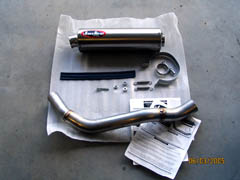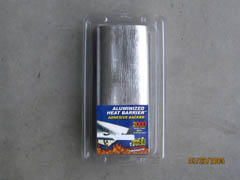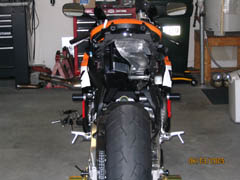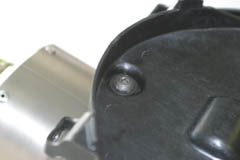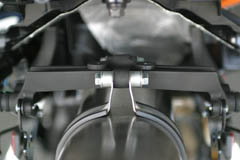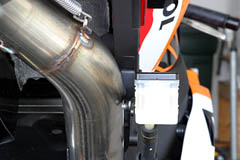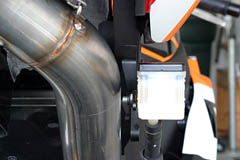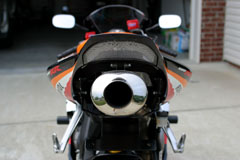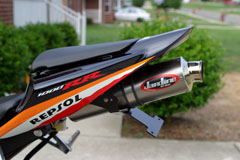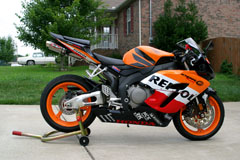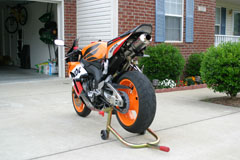|
|
Honda CBR 1000RR Jardine RT-One Slip On July 2005 I conducted quite a bit of research when trying to decide which exhaust system to purchase for the 1000RR. I called several exhaust manufacturers from Arata to Yoshimura and talked to their representatives and engineers. I searched the web, had message board discussions, downloaded sound clips, and analyzed dyno charts. After about 2 months of research I finally decided to go with the re-designed Jardine RT-One Titanium Slip On. There were several reasons I decided to purchase the Jardine system. I was looking to save weight, gain some power over stock, I wanted a system that looked right on the bike, and sounded good as well. The Jardine Ti Slip On fit the bill and the price was excellent. When choosing an exhaust system, you'll need to make your decision based on the riding you plan to do on the bike. Slip on exhausts tend to make more sense for street bikes as slip ons typically provide more useable power in the mid RPM ranges. Full systems make most of their power in the higher RPM range. I decided a slip on exhaust would be the best way to go for my street bike. If you race or spend 90% of your time on the track trying to beat your own personal lap record, a full system would be better for you as you spend more time in the higher RPM ranges. If a full system is what you're looking for I'd recommend Arata or Sato. Arata will be releasing a new "box" style end can that exits the bike straight in the near future. If you're looking for maximum power gain and don't mind a crooked end can then Sato is the best slip on available at the time of this writing. However, the new Arata box end can looks very promising, although at the time of this writing I've seen no dyno testing for this new Arata. Sato slip ons provide around an 8HP gain, which is the most I've seen from a slip on exhaust, with great mid range gains and I'd expect the new Arata to produce the same. The Jardine RT-One Slip On system includes the end can, complete one piece down pipe, silicon inlay, exhaust can strap, down pipe clamp, springs, bolts, and instructions. This system replaces the entire stock exhaust system from the collector back. Some exhaust systems only replace pipe back to the stock connector pipe. Jardine seems to have done a pretty good job of designing the system. If I were the designer, there are only a couple of small changes I would make, one being to make the down pipe and exhaust can end caps titanium rather than stainless steel. However, if those changes were made expect a MUCH higher price for this system. The Jardine down pipe is 2.25 inches (57mm) in diameter throughout. The stock down pipe is 2 inches (50mm) in diameter in most places with the connector pipe dropping down to 1.875 inches (48mm) in diameter at its connection point.
Some exhaust manufacturers have designed their exhaust cans to exit the rear of the 1000RR with a bias toward the left side of the bike, aka crooked. Of the systems that exit the bike straight, some use a full size can which causes the exhaust can to protrude from the rear of the bike farther than I find aesthetically pleasing. I wanted the exhaust tip to exit just past the tail light. It seems most exhaust manufacturers used one of their standard end cans and bent up a down pipe to connect it to the 1000RR's collector. The problem comes in with the limited space under the tail of the 1000RR. A full length end can has to be placed crooked under the tail, or protrude from the rear of the bike a great deal in order to fit. Jardine's RT-One originally exited the 1000RR with this bias toward the left of the bike. In the summer of 2004 Jardine redesigned the RT-One, shortening the exhaust can by about 3 inches, and re-bent the down pipe. These two design changes make the newer design RT-One Slip Ons exit the rear of the 1000RR dead straight and even with the tail of the bike. Anything with a 2005 manufacture date should be the new design. The new Jardine can is 16 inches long tip to tip where the old design can is 19" long tip to tip. Weight loss is another important aspect. The stock exhaust is heavy at 12.46 lbs (5.65 Kg) including the heat shields, exhaust valve cables, and plastic pipe shield. The location of the stock exhaust greatly affects the bikes center of gravity. Once you lose that much weight up high on a bike you can actually feel the difference. The difference in weight between aluminum end cans and titanium end cans is around a pound to a pound and a half. The difference between titanium and carbon end cans is even less. I prefer titanium for it's light weight and low maintenance. The entire Jardine RT-One Titanium Slip On System weighed 5.46 lbs (2.60 Kg). The same pipe in aluminum weighs about 1.5 lbs (0.68 Kg) more. This system more than met my requirement of weight loss at 53.64% lighter than stock. I also have a few thoughts on exhaust note. Some people want to sneak around on their bikes. Others want to wake the dead. I wanted something in between. I've owned several exhaust systems from Sato to Akrapovich. I like a nice rumble at idle with the sound getting higher pitched in frequency as the RPMs climb. This Jardine RT-One is a great sounding pipe on the 1000RR. People tend to hear the bike and are less likely to switch lanes on me when I'm commuting, and the bike brings a big smile to my face when I grab a handful of throttle while out riding the twisties. I measured the sound level in decibels with a Radio Shack Model 33-2055 Digital Sound Level Meter. I took the measurements directly behind the bike in an open area with no structures within 20 feet of the motorcycle. I took measurements at 6 feet (1.83 meters) and 16 feet (4.88 meters) from the exhaust pipe at the same height in reference to the ground as the exhaust pipe. To see how this Jardine RT-One compares to other exhaust systems on the market, check out the Exhaust dB Database. I observed the following measurements for the Jardine RT-One Titanium Slip On:
*Keep in mind the dB scale is progressive, like the
Richter scale. If looking at the difference between My RT-One arrived well packaged and complete. Installation is fairly simple if you have minimal mechanical skill. Basically you remove the driver and passenger seats, as well as the tail section. You then remove the stock exhaust. I recommend you use the repair manual for information on removing the stock exhaust as there are a lot of little bolts and nuts that hold the muffler and heat shields in place. You'll also want to remove the right side rear set from the bike, and tuck it out of the way. You'll have to disconnect the rear brake light switch in order to move the right side rear set. Once you have the stock exhaust and heat shields removed I recommend putting some Cool-It or similar material on the under tray. This material is light weight, good to 2000 degrees F (1093 C), and adhesive backed. Use a plastic putty knife to get it to form to the shape of the under tray. This will allow you to leave the stock heat shields off the bike. Now install the Jardine stainless steel down pipe. Make sure to put the down pipe clamp on the end of the pipe that connects to the stock exhaust collector in such a way that you can get a wrench on the nut to tighten it once it's mounted to the bike. Also be sure this nut does not hit the right rear set once the rear set is reinstalled. Don't tighten this clamp yet. Next, put the end can on the down pipe. It may take some twisting back and forth to get the Jardine end can to completely seat on the down pipe. Once it's seated connect the retention springs to the end can and the down pipe. Put the silicone gasket around the end can retaining strap, then slide it over the end can. Remove the rear bolt in the sub frame and attach the Jardine end can retaining strap to the sub frame using the supplied Jardine bolt, nut, and spacers. Attach the springs to the end can then to the down pipe. Make sure everything is lined up properly, and the end can is exiting the bike straight. Once everything looks good, tighten all the bolts. You may need to shape the end can retaining strap a little before putting it over the end can. Attaching the end can retaining strap to the bike is much easier if you have someone there to assist as it's really a two person job. Shaping the end can retaining strap before putting it on the bike makes this much easier as well. I also recommend using a black bolt of some sort to fill the hole in the under tray toward the rear of the bike. Leaving this hole open will allow water to come into your tail section in the event your caught in the rain. I found a black button head bolt and self locking black nut at a hardware store for less than $1 US.
The instructions that came with my Jardine RT-One were a little confusing, as well as outdated, and there were some typos and mislabeled diagrams. I don't know if they've updated these instructions or not so if you've never installed a sport bike exhaust system before, I recommend you get someone that has some experience with this to assist you. I was unsure of how to install the included spacers for the end can retaining strap, but the way I have them installed seems to make the most sense, and my exhaust system is absolutely rock stable. My installation is different from Jardine's diagram, but the copy of the instructions that were included with my April 2005 manufacture date slip on seemed to be for the older design that exited the bike crooked.
There is one major issue to be aware of. At the time of this writing, some of the Jardine down pipes may have a problem with touching the rear brake reservoir bracket on the bike once all the bolts are tightened down. My initial down pipe had this problem, and a few members of the www.1000rr.net message board that I frequent have had this issue as well. Others I've spoken with have not experienced this, however. I tried several mounting configurations to alleviate this issue to no avail. When I could not correct the problem, I made a call to Jardine and explained the situation. After some convincing that I had installed the system properly, Jardine sent me a new down pipe at no charge with a UPS return label to ship the defective pipe back to them. Once you get to the point of tightening all the bolts, check the down pipe to make sure you have around 3/16 of an inch (4-5mm) of gap between the down pipe and the rear brake reservoir bracket. Reference the photographs below showing the difference. In the image on the left you can clearly see the down pipe touching, the image on the right shows the amount of space that should be present. I recently went on a 200 mile (322 Km) ride in 90 degree F (32 C) temps and had no problems with the corrected down pipe. For the money, I think the Jardine is a nice exhaust system. It sounds great, fits the bike well, and saves weight. I'd theorize a 3-5 HP gain with this exhaust. I'm currently using the Dynojet Erion Slip On map with my Jardine RT-One and it really seems to be running just right as the exhaust tip is a light dark grey/tan color and I don't notice any soot on hard throttle. There are higher end exhaust systems on the market that have titanium down pipes and end caps, and even titanium can internals, however those come at a substantially higher price. The pictures below show the installed system as well as the Jardine Fender Eliminator I used to tidy up the rear a little more.
This page is part of a frame set. If you reached this page via a search engine please click here to go to the main page. |
